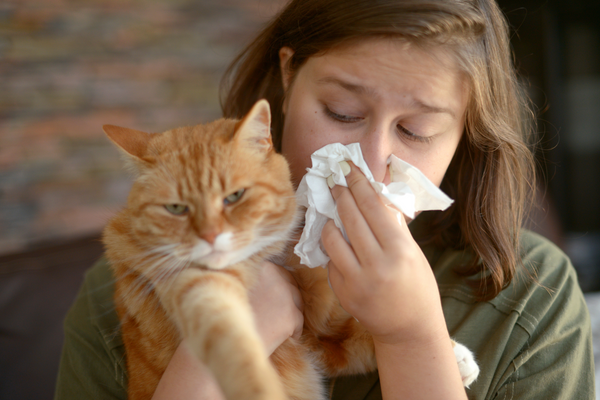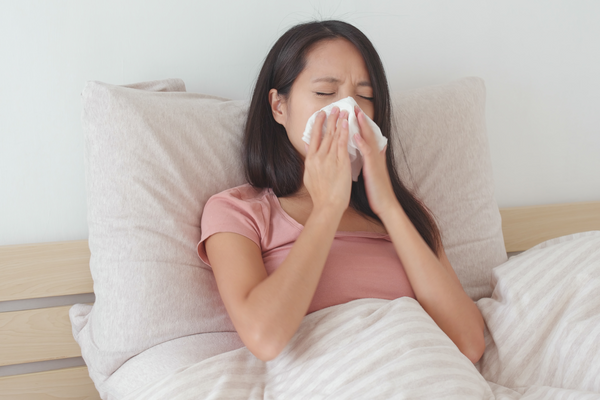Are Your Allergies Worse Indoors? A Complete Guide to a Healthier Indoor Environment

What Causes Indoor Allergies?
If you're regularly sneezing and sniffling more indoors than out, your home may be the source of your misery. An overly reactive immune system is triggered when a sensitive individual encounters an allergen - sources abound in most households. One study found that over 50% of the U.S. homes assessed had at least six detectable allergens present, and nearly 46% had at least three allergens exceeding elevated levels.
Fortunately, there are ways that you can significantly reduce the number of environmental allergens in your home, improve indoor air quality, and help prevent your bothersome allergy symptoms from happening in the first place. Knowing how to avoid or minimize allergy triggers will go a long way toward reclaiming the blissful indoor environment you deserve.
Allergens and Indoor Air Quality
According to the U.S. Environmental Protection Agency (EPA), a growing body of evidence indicates that the air inside homes and other indoor environments can be much more polluted than outdoor air––even in the largest and most industrialized cities. And with the average person spending about 90% of their time indoors, air quality can hugely impact health.
Indoor air quality can be drastically different from outdoor air quality due to many factors, including the level of ventilation, the types of cleaning and household products used, whether or not pets are present, smoke from fireplaces or wood stoves, and sources of mold growth such as damp basements. All these factors contribute to an environment with elevated levels of allergens and irritants that can worsen your allergy symptoms if not appropriately addressed.
Common Symptoms of Indoor Allergies
If your nasal stuffiness, sneezing, watery eyes, wheezing, and constant post-nasal drip bother you year-round, then you most likely have nonseasonal hay fever, sometimes referred to as perennial allergic rhinitis. This condition is typically caused by indoor allergens such as dust mites, cockroach parts, mold, and animal dander.
If you think you’re suffering from indoor allergies, consult your doctor or allergist to determine what’s causing your symptoms; allergy tests can confirm what triggers your allergic symptoms.
How to Manage Indoor Allergens and Improve Air Quality
More than 50 million Americans experience allergies yearly, and many suffer year-round allergy symptoms caused by indoor allergens. When these symptoms occur year-round, the condition is called perennial allergic rhinitis or nasal allergies.
As a long-term solution, the most effective treatment option is neutralizing the source of allergies inside your home. The most common indoor allergens include dust mites, mold, and pet dander. Cockroaches can also trigger allergy symptoms.
Dust Mites
Dust mites are the most common indoor allergens. These microscopic bugs live in soft furniture, feeding on dead skin cells shed by humans and animals. While mites don’t bite (thank goodness!), they can cause a long list of uncomfortable allergy symptoms, cause asthma flares, and lead to chronic fatigue. Dust mites thrive in warm, humid environments, making them particularly common during the winter when moisture is higher indoors and windows remain closed for extended periods. Both people and pets can be affected by dust mite allergies. Dust mites are nearly everywhere. And while it’s not possible to completely eradicate them, their impact can be greatly reduced.
Tip: How to Combat Dust Mite Allergens in the Home
Consider these tips for managing dust mite allergens:
- Reduce clutter around your home so that dust has fewer places to accumulate.
- Wash your bedding weekly with an anti-allergen laundry detergent. Heads up, “anti-allergen” is key. Using standard detergent will leave dust mites behind.
- Clean carpets, rugs, and upholstery at least twice per year. Start by vacuuming thoroughly with a HEPA vacuum. Follow up with a carpet cleaner (or hot water extractor) along with our Dustmite & Flea Control to help keep dust mites from returning. Remember that dust mites thrive in places with high humidity, so make sure you allow plenty of time for thorough drying after using a hot water vacuum. A fan will help speed up your drying time.
Dustmite & Flea Control works by coating the mite’s food source so populations die off. This is great news for allergy sufferers since killing mites gets right to the allergen source. With dust mites eliminated, they can no longer produce particles that contribute to allergy symptoms.
Pet Allergens
Pet allergens are also a major source of indoor allergies. As many as three in 10 people with allergies have allergic reactions to cats and dogs, with cat allergies being twice as common as dog allergies. Animal dander (dead skin flakes) becomes airborne and accumulates on carpets, curtains, bedding, furniture, and other surfaces where pets spend a lot of time. Cat dander is particularly problematic because cats groom themselves often, increasing their shedding and spreading allergens. Not to mention, cat dander can stick around for months. Thankfully, in many cases, allergies to pet dander can be managed.
Tip: How to Combat Pet Allergens in the Home
- Start by keeping pets out of key areas like the bedroom or home office. Remember, pet allergen levels are much higher in rooms where animals are physically present.
- Bathe pets regularly with an anti-allergen pet shampoo to remove allergens from their fur.
- For quick cleanup, cover furniture with washable covers or throw blankets. Use an anti-allergen laundry detergent to wash the covers weekly and other washables (such as pet beds) to keep the allergen load down.
- Vacuum regularly (daily if you have a pet that sheds) with a vacuum cleaner equipped with a HEPA filter to prevent the outflow of the contents.
- Use an anti-allergen solution to neutralize the threat of pet dander allergens from bedding, furniture, rugs, carpeting, upholstery, pet beds, and more.
Mold
Mold is another common indoor allergen that can cause sneezing, coughing, coughing, and other allergy symptoms. Mold grows in moist places such as bathrooms or basements without adequate ventilation or air circulation. Mold spores trigger allergies, and they are released into the air when mold grows on damp surfaces like floors or walls.
Tip: How to Combat Mold Allergens in the Home
Mold is an allergen that can trigger sneezing, coughing, and other allergy symptoms. To combat mold allergens in the home, start by addressing any leaks. Next, remove mold from surfaces and treat it with a mold inhibitor. Keep in mind that mold needs water to survive, so it’s crucial to make sure the area drys completely.
For extensive mold problems, consider hiring a professional trained in mold cleanup. Some molds are highly toxic, and even less dangerous molds can cause problems for people with allergies, compromised immune systems, or respiratory issues. Generally, the rule of thumb is to seek the help of a professional if the mold covers ten or more square feet.
To control mold growth around the home:
- Clean bathrooms regularly with a mold inhibitor to neutralize mold spores.
- Use an exhaust fan or a dehumidifier to help eliminate excess moisture in the bathroom.
- Wash musty towels, bed linens, and other washables with an anti-allergen laundry detergent. Remember, most laundry products don’t have the right ingredients to remove mold or the odors caused by mold, leaving mold spores, stains, and funk behind.
Cockroach Allergens
According to the American College of Allergy, Asthma, & Immunology (ACAAI), cockroaches’ saliva, feces, and shedding body parts can trigger asthma and allergies. Cockroaches live in all types of buildings and neighborhoods. Having these unsightly critters lurking doesn’t mean you have a dirty home. The National Pest Management Association reports that over 60% of homes in the U.S. contain cockroach allergens, and that number rises to 98% of homes in urban areas.
Tip: How to Combat Cockroach Allergens in the Home
If you notice cockroaches around your home, start by blocking off any areas where they can enter, including crevices, wall cracks, and windows. Just like mold, roaches need water to survive, so fix any leaks that could unknowingly give cockroaches access to water. Keep food containers and garbage cans sealed. Vital Oxide removes allergens from cockroaches (as well as dust mites, pet dander, and molds) and is safe for use on surfaces that water won’t harm; use it to clean all around the home. Consult an exterminator if you believe you have a cockroach infestation.
Reducing Allergen Build-Up in the Home During Winter Months
Spending more time indoors during the winter can make you more vulnerable to allergies. This is because windows and doors are kept closed due to cold temperatures, and allergens can accumulate inside your home. This build-up of allergens can cause an increase in allergy symptoms like itchy, watery eyes and runny nose.
The Ecology Works Anti-Allergen Solution neutralizes common environmental allergens from the home quickly and efficiently to eliminate the source of your allergy symptoms.
According to the American Academy of Allergy, Asthma, and Immunology (AAAAI), the most common indoor allergens that may trigger symptoms in the winter include pet dander, mold spores, dust mites, and cockroach sheddings and droppings.
Thankfully, there are several ways to reduce allergen buildup in the home during winter months.
- Ventilate! Open the windows for a few minutes daily (or as often as possible!) for fresh air circulation throughout the house.
- Dust at least once weekly (or daily if needed) with a damp cloth and anti-allergen solution.
- Vacuum carpets, rugs, upholstery, furniture, pet beds, curtains, and other soft surfaces using a HEPA vacuum cleaner.
- Following vacuum cleaning, spray soft surfaces with an anti-allergen solution to neutralize allergens on contact and diminish their threat.
Did you know? Many people carry on the annual tradition of spring cleaning to declutter and remove the dust, grime, and allergens that have built up inside during the colder winter months.
Neutralize Allergens in Your Home Quickly & Efficiently with The Ecology Works Anti-Allergen Products
Indoor allergies can be a major nuisance year-round, and especially during cold winter months when windows are kept closed for longer periods. This results in poor indoor air quality and worsens allergies and asthma if not addressed properly. While it’s not possible to completely rid your home of allergens, there are plenty of things you can do to reduce the number of allergens in your home.
With The Ecology Works Anti-Allergen Products, you'll have the solutions needed to quickly and efficiently neutralize common indoor allergens like dust mites, pet dander, and mold spores from your home –– so you can breathe easier. Our products eliminate allergens directly at their source—providing effective relief.
Have questions about reducing environmental allergens or irritants inside your home or business? We have answers! The Ecology Works has been helping folks with allergies and asthma since 1993. We can help you select the products you need to live a better, allergen-free life. Please feel free to Contact Us or message us on Facebook. No question is too small! We're here to help.




